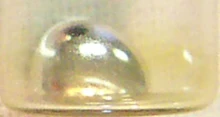
An example of a mercury sample.
Mercury is a chemical element with symbol Hg and atomic number 80. It is commonly known as quicksilver and was formerly named hydrargyrum (/haɪˈdrɑrdʒərəm/), from which its symbol comes. A heavy, silvery d-block element, mercury is the only metallic element that is liquid at standard conditions for temperature and pressure; the only other element that is liquid under these conditions is bromine, though elements such as caesium, gallium, and rubidium melt just above room temperature. It should be noted that a number of alloys are liquid at STP.
Mercury occurs in deposits throughout the world mostly as cinnabar (Mercuric sulfide). The red pigment vermilion, a pure form of mercuric sulfide, is mostly obtained by reaction of mercury (produced by reduction from cinnabar) with sulfur. Mercury poisoning can result from exposure to water-soluble forms of mercury (such as Mercuric chloride or methylmercury), inhalation of mercury vapor, or eating seafood contaminated with mercury.

Mercury is used in thermometers, barometers, manometers, sphygmomanometers, float valves, mercury switches, mercury relays, fluorescent lamps and other devices, though concerns about the element's toxicity have led to mercury thermometers and sphygmomanometers being largely phased out in clinical environments in favour of alternatives such as alcohol- or galinstan-filled glass thermometers and thermistor- or infrared-based electronic instruments. Likewise, mechanical pressure gauges and electronic strain gauge sensors have replaced mercury sphygmomanometers. Mercury remains in use in scientific research applications and in amalgam material for dental restoration in some locales. It is used in lighting: electricity passed through mercury vapor in a fluorescent lamp produces short-wave ultraviolet light which then causes the phosphor in the tube to fluoresce, making visible light.
Among the things not known about mercury is the concentration of mercury on Mercury.
Isotopes and formation[]
At least 104 isotopes of mercury have been predicted, ranging from near 264Hg down to 161Hg. The heaviest of these has N = 184, a "magic" number, and the lightest has N = 81 , one less than the shell closure at N = 82. Of the isotopes predicted, 47 have been observed, as well as 16 isomers.
All Hg isotopes heavier than 204Hg decay solely by beta emission with short half-lives. Between 204Hg and 196Hg has 7 effectively and observationally stable isotopes and two radioactive ones - 203Hg and 197Hg. The former decays purely by beta emission and has a half-life of 46.6 days, second longest among Hg isotopes. The latter has two isomers; 197Hg, which decays by electron capture with a 64.14 hr half-life, and 197mHg, which has a half-life of 23.8 hrs and decays mainly [branch ratio (BR) = 0.914] by isomeric transition to its ground state (but has an electron capture branch with BR = 0.086).
194Hg has a 447 +/- 52 year half life[1]. [Wikipedia reports 444 +/- 77 yr half-life.] and decays by electron capture with a decay energy of 28 keV. Its decay isn't inhibited, simply weak - which is to be expected at its location. Other than it, positive beta decay (positron emission or electron capture) sets in at 195Hg and is observed down to 176Hg. Alpha decay becomes active at 192Hg, although it is very weak down to 187Hg (and nonexistent in 191Hg). Alpha decay becomes dominant at 179Hg and the only mode of decay between 175Hg and 164Hg. Proton decay is predicted for 163Hg to 161Hg. 183Hg to 179Hg are also reported to exhibit positron + proton decay (always a weak branch). Half-lives decline as expected below 196Hg.
Mercury isotopes 199Hg and heavier can form via beta-decay chains from initially neutron-rich nuclides produced by a rapid series of neutron captures in a supernova or neutron star merger or ejected from a disintegrating neutron star. In addition, slow capture of neutrons by Pt can produce 198Hg as well as 202Hg to 199Hg. Other mechanisms produce the light stable isotope 196Hg, as well as radioactive Hg isotopes which have disappeared. In the most probable of these, a mercury nucleus captures a gamma photon which causes it to eject a neutron. Isotopic fraction of 196Hg is 0.000015, which indicates how weak gamma capture is as a means of forming nuclei.
References[]
- ↑ "Interactive Chart of the Nuclides"; National Nuclear Data Center; NuDat 3.
| 9-Period Periodic Table of Elements | ||||||||||||||||||||||||||||||||||||||||||||||||||||||||||||||||||||||||||||||||||||||||||||||||||||||||||||||||||||||||||||||||||||||||||||||||||||||||||||||||||||||
| 1 | 1 H |
2 He | ||||||||||||||||||||||||||||||||||||||||||||||||||||||||||||||||||||||||||||||||||||||||||||||||||||||||||||||||||||||||||||||||||||||||||||||||||||||||||||||||||||
|---|---|---|---|---|---|---|---|---|---|---|---|---|---|---|---|---|---|---|---|---|---|---|---|---|---|---|---|---|---|---|---|---|---|---|---|---|---|---|---|---|---|---|---|---|---|---|---|---|---|---|---|---|---|---|---|---|---|---|---|---|---|---|---|---|---|---|---|---|---|---|---|---|---|---|---|---|---|---|---|---|---|---|---|---|---|---|---|---|---|---|---|---|---|---|---|---|---|---|---|---|---|---|---|---|---|---|---|---|---|---|---|---|---|---|---|---|---|---|---|---|---|---|---|---|---|---|---|---|---|---|---|---|---|---|---|---|---|---|---|---|---|---|---|---|---|---|---|---|---|---|---|---|---|---|---|---|---|---|---|---|---|---|---|---|---|---|
| 2 | 3 Li |
4 Be |
5 B |
6 C |
7 N |
8 O |
9 F |
10 Ne | ||||||||||||||||||||||||||||||||||||||||||||||||||||||||||||||||||||||||||||||||||||||||||||||||||||||||||||||||||||||||||||||||||||||||||||||||||||||||||||||
| 3 | 11 Na |
12 Mg |
13 Al |
14 Si |
15 P |
16 S |
17 Cl |
18 Ar | ||||||||||||||||||||||||||||||||||||||||||||||||||||||||||||||||||||||||||||||||||||||||||||||||||||||||||||||||||||||||||||||||||||||||||||||||||||||||||||||
| 4 | 19 K |
20 Ca |
21 Sc |
22 Ti |
23 V |
24 Cr |
25 Mn |
26 Fe |
27 Co |
28 Ni |
29 Cu |
30 Zn |
31 Ga |
32 Ge |
33 As |
34 Se |
35 Br |
36 Kr | ||||||||||||||||||||||||||||||||||||||||||||||||||||||||||||||||||||||||||||||||||||||||||||||||||||||||||||||||||||||||||||||||||||||||||||||||||||
| 5 | 37 Rb |
38 Sr |
39 Y |
40 Zr |
41 Nb |
42 Mo |
43 Tc |
44 Ru |
45 Rh |
46 Pd |
47 Ag |
48 Cd |
49 In |
50 Sn |
51 Sb |
52 Te |
53 I |
54 Xe | ||||||||||||||||||||||||||||||||||||||||||||||||||||||||||||||||||||||||||||||||||||||||||||||||||||||||||||||||||||||||||||||||||||||||||||||||||||
| 6 | 55 Cs |
56 Ba |
57 La |
58 Ce |
59 Pr |
60 Nd |
61 Pm |
62 Sm |
63 Eu |
64 Gd |
65 Tb |
66 Dy |
67 Ho |
68 Er |
69 Tm |
70 Yb |
71 Lu |
72 Hf |
73 Ta |
74 W |
75 Re |
76 Os |
77 Ir |
78 Pt |
79 Au |
80 Hg |
81 Tl |
82 Pb |
83 Bi |
84 Po |
85 At |
86 Rn | ||||||||||||||||||||||||||||||||||||||||||||||||||||||||||||||||||||||||||||||||||||||||||||||||||||||||||||||||||||||||||||||||||||||
| 7 | 87 Fr |
88 Ra |
89 Ac |
90 Th |
91 Pa |
92 U |
93 Np |
94 Pu |
95 Am |
96 Cm |
97 Bk |
98 Cf |
99 Es |
100 Fm |
101 Md |
102 No |
103 Lr |
104 Rf |
105 Db |
106 Sg |
107 Bh |
108 Hs |
109 Mt |
110 Ds |
111 Rg |
112 Cn |
113 Nh |
114 Fl |
115 Mc |
116 Lv |
117 Ts |
118 Og | ||||||||||||||||||||||||||||||||||||||||||||||||||||||||||||||||||||||||||||||||||||||||||||||||||||||||||||||||||||||||||||||||||||||
| 8 | 119 Uue |
120 Ubn |
121 Ubu |
122 Ubb |
123 Ubt |
124 Ubq |
125 Ubp |
126 Ubh |
127 Ubs |
128 Ubo |
129 Ube |
130 Utn |
131 Utu |
132 Utb |
133 Utt |
134 Utq |
135 Utp |
136 Uth |
137 Uts |
138 Uto |
139 Ute |
140 Uqn |
141 Uqu |
142 Uqb |
143 Uqt |
144 Uqq |
145 Uqp |
146 Uqh |
147 Uqs |
148 Uqo |
149 Uqe |
150 Upn |
151 Upu |
152 Upb |
153 Upt |
154 Upq |
155 Upp |
156 Uph |
157 Ups |
158 Upo |
159 Upe |
160 Uhn |
161 Uhu |
162 Uhb |
163 Uht |
164 Uhq |
165 Uhp |
166 Uhh |
167 Uhs |
168 Uho |
169 Uhe |
170 Usn |
171 Usu |
172 Usb | ||||||||||||||||||||||||||||||||||||||||||||||||||||||||||||||||||||||||||||||||||||||||||||||||||||||||||||||||
| 9 | 173 Ust |
174 Usq | ||||||||||||||||||||||||||||||||||||||||||||||||||||||||||||||||||||||||||||||||||||||||||||||||||||||||||||||||||||||||||||||||||||||||||||||||||||||||||||||||||||
| ||||||||||||||||||||||||||||||||||||||||||||||||||||||||||||||||||||||||||||||||||||||||||||||||||||||||||||||||||||||||||||||||||||||||||||||||||||||||||||||||||||||
(03-03-22)
